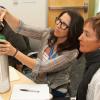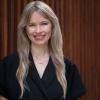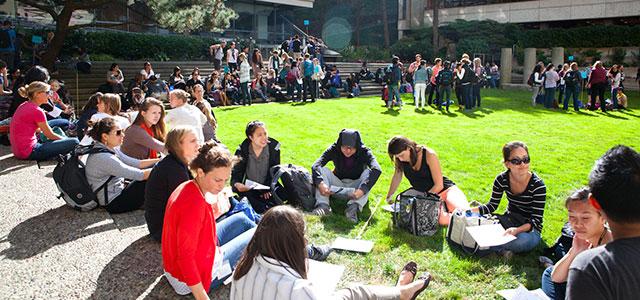
First-year students from UCSF’s five professional programs participate in an introductory workshop on interprofessional education (photos by Elisabeth Fall).
Cross-Training
On a sunny afternoon in early October, UC San Francisco School of Nursing student Alex Freeman sat on the grass in Saunders Court with other first-year students from UC San Francisco’s five professional programs. To an outsider, Freeman and her colleagues looked like they were enjoying an afternoon break.
Instead, they were in class. Getting acquainted and sharing background information in a casual setting was part of an assignment for a two-hour introductory workshop on interprofessional education (IPE).
The Oct. 7 event was the first in a series of three workshops, known as IPE Days, that take place throughout the 2013-2014 academic year. Required for first-year students, IPE Days are part of a growing effort by UCSF to boost didactic and clinical opportunities for students to interact, collaborate and train across professions.
In addition to colleagues from the School of Nursing, Freeman’s group also consisted of students from the schools of medicine, dentistry and pharmacy and the graduate program in Physical Therapy and Rehabilitation Science. Their group was one of dozens arranged around the square outside the School of Nursing.
After short introductions, Freeman and her peers turned their focus to the topic at hand – interprofessional collaboration – by first describing times when, as clinicians or as patients, they dealt with health professionals not working together as a team.
Freeman, who is in the Acute Care Pediatric Nurse Practitioner program, worked for two years as a pediatric nurse at UCLA’s Mattel Children’s Hospital. The students nodded with recognition as she described a doctor getting angry after learning a patient had not received a medication he had ordered. Freeman herself was frustrated with the pharmacy department until she learned how backed up they were.
“Sometimes you’re limited in what you can do,” she says. “It would be great if we could talk to people in other professions in ways so that we could better understand what we’re all up against. Perhaps if we could do that more, we’d be more efficient in how we help patients.”
The Need for IPE
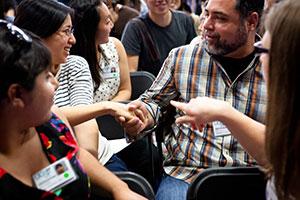 According to the World Health Organization, IPE is “when students from two or more professions learn about, from, and with each other to enable effective collaboration and improve health outcomes.”
According to the World Health Organization, IPE is “when students from two or more professions learn about, from, and with each other to enable effective collaboration and improve health outcomes.”
“IPE plays a crucial role in preparing our trainees for patient-centered care, which relies on teamwork and knowledge sharing to improve patient outcomes,” says Kimberly Topp, chair of the Department of Physical Therapy and Rehabilitation Science and chair of the executive committee that directs UCSF’s two-year-old Center for Innovation in Interprofessional Education.
The center is predicated on the idea that teamwork will be crucial to tackling the massive challenges of providing health care in the coming century. These challenges include the increasing number of older patients with complex chronic illnesses, the growing diversity of patient populations, and the millions of new patients entering the system as a result of the Affordable Care Act.
Of course, interprofessional collaboration is hardly new; it goes back to Florence Nightingale’s vision of nurses teaming up with physicians to provide care for soldiers in the Crimean War in the 1850s. But the health care model that emerged in the 20th century and persists today is hierarchical and highly specialized. A common concern of major health care providers is that recent graduates lack teamwork experience, so hospitals need to do additional on-the-job training.
“The professional schools have been doing a wonderful job for the past 150 years, producing physicians, nurses and practitioners who are competent in their own right,” says Scott Reeves, the IPE center’s former director and a social scientist and expert in IPE, who edits the Journal of Interprofessional Care.
“But you can’t just be a great clinician,” says Topp. “You need to have the ability to relate to, negotiate with and learn from other professionals to provide true patient-centered care.”
Small-group sessions are the cornerstone of UCSF’s IPE training because they offer students a one-on-one way to role-play, brainstorm and develop an appreciation for different perspectives and expertise.
Bringing IPE to UCSF
The momentum for IPE at UCSF has been building since the early 2000s. Over the past decade, faculty have partnered with colleagues in other schools to develop classroom and clinical IPE opportunities.
Maria Wamsley, a clinical professor in the School of Medicine, and colleagues from other schools piloted a curriculum for student teams to do mock patient assessments and care plans in the Kanbar Center for Simulation, Clinical Skills and Telemedicine Education. Faculty from the schools of nursing and dentistry have also taken nurse practitioner and dental students into Oakland middle schools to provide basic dental screenings and health education as part of a national initiative called Elev8.
Then, to centralize campus efforts around IPE by providing administrative and communications support for programs like IPE Days, UCSF established the Center for Innovation in Interprofessional Education in late 2011. The center also promotes curricular innovation and collaboration, helping UCSF faculty and staff overcome challenges that large institutions face in working concertedly on curricular advancements.
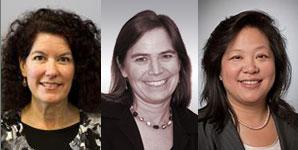 From left: Kimberly Topp, Maria Wamsley, Angel Chen These challenges include lining up schools’ academic calendars, finding ways to integrate IPE concepts into existing courses, and training veteran faculty to think more in interdisciplinary terms. An important goal of IPE is to help students and faculty rethink traditional hierarchical roles that usually involve a physician issuing commands that other team members don’t question.
From left: Kimberly Topp, Maria Wamsley, Angel Chen These challenges include lining up schools’ academic calendars, finding ways to integrate IPE concepts into existing courses, and training veteran faculty to think more in interdisciplinary terms. An important goal of IPE is to help students and faculty rethink traditional hierarchical roles that usually involve a physician issuing commands that other team members don’t question.
“To optimize the quality and safety of the care we provide, we need to ensure that all members of the team feel comfortable speaking out when they have a concern,” Wamsley says. “To do this, we need to flatten the traditional hierarchy.”
Rolling Out IPE
The IPE center’s Curriculum Development Working Group, co-chaired by Wamsley and Angel Chen, an associate clinical professor and vice chair in the School of Nursing’s Department of Family Health Care Nursing, created the agenda for the October 7 IPE Day.
The event started with some 500 first-year students meeting in the gym at Millberry Union. San Francisco Fire Department Chief Joanne Hayes-White offered a keynote address, explaining that teamwork is essential to how firefighters work together and with police, state and federal agencies to save lives in emergencies, from a house fire to a major disaster like the July 6, 2013, crash of Asiana Airlines Flight 214 at San Francisco International Airport.
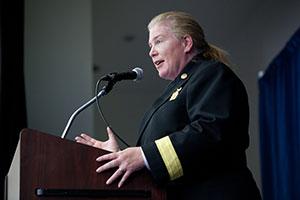 San Francisco Fire Department Chief Joanne Hayes-White Though they are both passionate about IPE, Wamsley and Chen approach it from different professional experiences. Chen is an RN and nurse practitioner who specializes in pediatric urology. This field has always relied on teams of surgeons, nurses and others working together to manage care for young patients with chronic conditions, such as urinary tract disorders and spina bifida. “With a child with a complex set of issues and special health care needs, it really requires collaboration and buy-in from the different professionals involved,” she says. “For me that’s the way of being.”
San Francisco Fire Department Chief Joanne Hayes-White Though they are both passionate about IPE, Wamsley and Chen approach it from different professional experiences. Chen is an RN and nurse practitioner who specializes in pediatric urology. This field has always relied on teams of surgeons, nurses and others working together to manage care for young patients with chronic conditions, such as urinary tract disorders and spina bifida. “With a child with a complex set of issues and special health care needs, it really requires collaboration and buy-in from the different professionals involved,” she says. “For me that’s the way of being.”
An internist, Wamsley also had to learn on the job about teamwork – “not the most optimal setting,” she says – and in a field where collaboration wasn’t emphasized. She says she came out of medical school with no clear idea of what pharmacists did. “I used to think the pharmacist was the person at Walgreens who doles out pills,” she says. “I definitely lean on them more now in terms of knowing whether it would be safe to start a medication in particular patients or for suggestions on managing patients’ diabetes.”
The two professionals and their colleagues rolled out IPE days in the fall of 2012 for students starting in the 2012-2013 school year. These students, now in their second year, returned for an October 14 session on conflict resolution and leadership. First-year students will participate in further IPE sessions in January and April on roles and responsibilities and conflict resolution.
Wamsley, Chen and the Curriculum Development Working Group are now developing a six-module online IPE class that will be offered through Coursera. UCSF students will combine the online learning with face-to-face sessions starting in the 2014-2015 year.
Student-Directed Movement
The push for interprofessional education doesn’t just come from national health organizations, such as the Institute of Medicine, says Wamsley, but from students as well. “Here we are at a health sciences campus, but they see so little cross talk between different professions,” she says.
That desire to understand different perspectives was definitely in evidence in the small groups on October 7. In Freeman’s group, a pharmacy student expressed both surprise and admiration after talking to a nursing student and learning that she and other nursing colleagues bring so much work experience to their UCSF graduate studies.
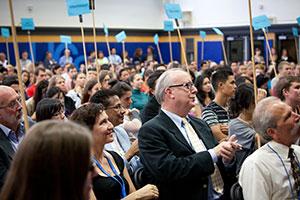 UCSF School of Nursing Dean David Vlahov (center) with fellow deans and students at the opening of IPE Day The main assignment for the groups was a game to brainstorm ideas about how to improve interprofessional training at UCSF. Freeman’s group proposed increasing opportunities for students to shadow professionals working in different disciplines and to create an online message board for students to share ideas about collaboration.
UCSF School of Nursing Dean David Vlahov (center) with fellow deans and students at the opening of IPE Day The main assignment for the groups was a game to brainstorm ideas about how to improve interprofessional training at UCSF. Freeman’s group proposed increasing opportunities for students to shadow professionals working in different disciplines and to create an online message board for students to share ideas about collaboration.
A nearby group, which included nursing student Fielding Elliott, proposed establishing a student-run interprofessional clinic. “We want to benefit the patient by having access to multiple disciplines under one roof,” he says.
Fielding has worked in emergency rooms in North Carolina and Washington, DC, and is concerned about the numbers of people without dental insurance coming in for treatment of severe tooth pain and other mouth problems. Emergency rooms typically lack the ability to make sure these patients get follow-up dental care. Others in his group shared his concerns, and dentistry students agreed that their participation in such a clinic would be important.
Fielding left the session excited and inspired: “I thought the exercise was a great experience that allowed my group to brainstorm on a multidisciplinary approach to benefit patients in a concise manner, under one roof. This exercise allowed us to realize that we can all have a large impact here at UCSF, especially if we are all united.”


